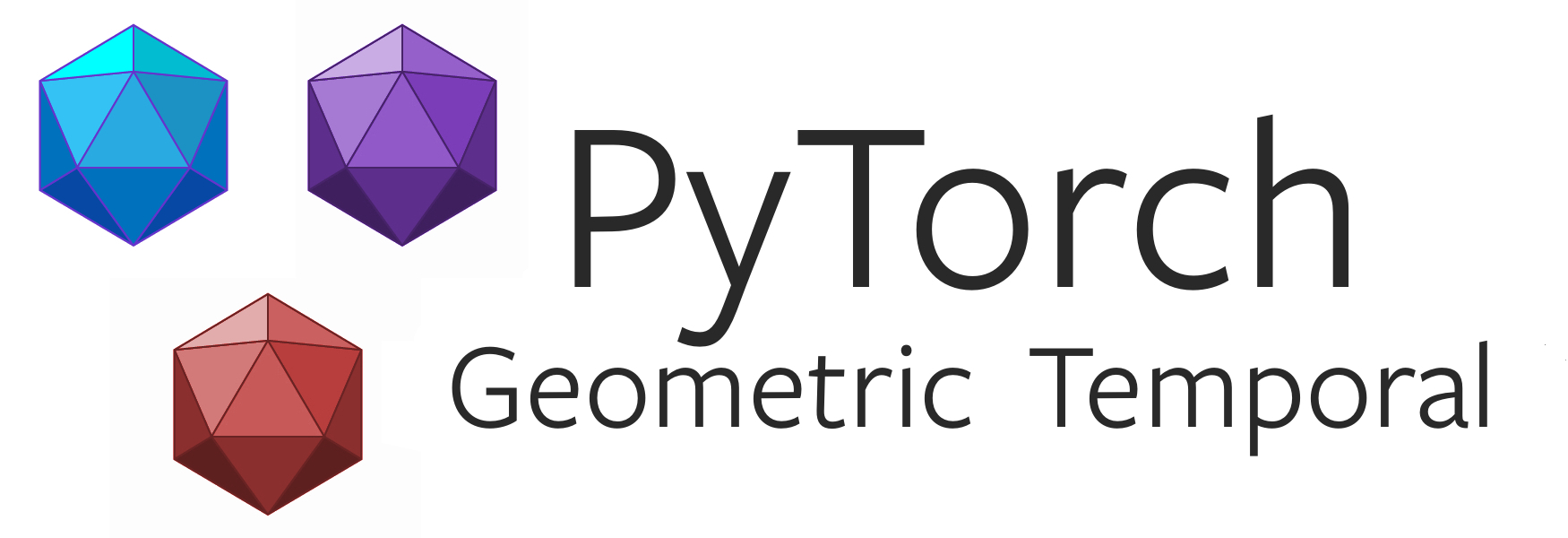Documentation | External Resources | Datasets
PyTorch Geometric Temporal is a temporal (dynamic) extension library for PyTorch Geometric.
The library consists of various dynamic and temporal geometric deep learning, embedding, and spatio-temporal regression methods from a variety of published research papers. Moreover, it comes with an easy-to-use dataset loader, train-test splitter and temporal snaphot iterator for dynamic and temporal graphs. The framework naturally provides GPU support. It also comes with a number of benchmark datasets from the epidemological forecasting, sharing economy, energy production and web traffic management domains. Finally, you can also create your own datasets.
The package interfaces well with Pytorch Lightning which allows training on CPUs, single and multiple GPUs out-of-the-box. Take a look at this introductory example of using PyTorch Geometric Temporal with Pytorch Lighning.
We also provide detailed examples for each of the recurrent models and notebooks for the attention based ones.
Case Study Tutorials
We provide in-depth case study tutorials in the Documentation, each covers an aspect of PyTorch Geometric Temporal’s functionality.
Incremental Training: Epidemiological Forecasting Case Study
Cumulative Training: Web Traffic Management Case Study
Citing
If you find PyTorch Geometric Temporal and the new datasets useful in your research, please consider adding the following citation:
@inproceedings{rozemberczki2021pytorch,
author = {Benedek Rozemberczki and Paul Scherer and Yixuan He and George Panagopoulos and Alexander Riedel and Maria Astefanoaei and Oliver Kiss and Ferenc Beres and Guzman Lopez and Nicolas Collignon and Rik Sarkar},
title = {{PyTorch Geometric Temporal: Spatiotemporal Signal Processing with Neural Machine Learning Models}},
year = {2021},
booktitle={Proceedings of the 30th ACM International Conference on Information and Knowledge Management},
pages = {4564–4573},
}A simple example
PyTorch Geometric Temporal makes implementing Dynamic and Temporal Graph Neural Networks quite easy - see the accompanying tutorial. For example, this is all it takes to implement a recurrent graph convolutional network with two consecutive graph convolutional GRU cells and a linear layer:
import torch
import torch.nn.functional as F
from torch_geometric_temporal.nn.recurrent import GConvGRU
class RecurrentGCN(torch.nn.Module):
def __init__(self, node_features, num_classes):
super(RecurrentGCN, self).__init__()
self.recurrent_1 = GConvGRU(node_features, 32, 5)
self.recurrent_2 = GConvGRU(32, 16, 5)
self.linear = torch.nn.Linear(16, num_classes)
def forward(self, x, edge_index, edge_weight):
x = self.recurrent_1(x, edge_index, edge_weight)
x = F.relu(x)
x = F.dropout(x, training=self.training)
x = self.recurrent_2(x, edge_index, edge_weight)
x = F.relu(x)
x = F.dropout(x, training=self.training)
x = self.linear(x)
return F.log_softmax(x, dim=1)Methods Included
In detail, the following temporal graph neural networks were implemented.
Recurrent Graph Convolutions
-
DCRNN from Li et al.: Diffusion Convolutional Recurrent Neural Network: Data-Driven Traffic Forecasting (ICLR 2018)
-
GConvGRU from Seo et al.: Structured Sequence Modeling with Graph Convolutional Recurrent Networks (ICONIP 2018)
-
GConvLSTM from Seo et al.: Structured Sequence Modeling with Graph Convolutional Recurrent Networks (ICONIP 2018)
-
GC-LSTM from Chen et al.: GC-LSTM: Graph Convolution Embedded LSTM for Dynamic Link Prediction (CoRR 2018)
-
LRGCN from Li et al.: Predicting Path Failure In Time-Evolving Graphs (KDD 2019)
-
DyGrEncoder from Taheri et al.: Learning to Represent the Evolution of Dynamic Graphs with Recurrent Models
-
EvolveGCNH from Pareja et al.: EvolveGCN: Evolving Graph Convolutional Networks for Dynamic Graphs
-
EvolveGCNO from Pareja et al.: EvolveGCN: Evolving Graph Convolutional Networks for Dynamic Graphs
-
T-GCN from Zhao et al.: T-GCN: A Temporal Graph Convolutional Network for Traffic Prediction
-
A3T-GCN from Zhu et al.: A3T-GCN: Attention Temporal Graph Convolutional Network for Traffic Forecasting
-
AGCRN from Bai et al.: Adaptive Graph Convolutional Recurrent Network for Traffic Forecasting (NeurIPS 2020)
-
MPNN LSTM from Panagopoulos et al.: Transfer Graph Neural Networks for Pandemic Forecasting (AAAI 2021)
Attention Aggregated Temporal Graph Convolutions
-
STGCN from Yu et al.: Spatio-Temporal Graph Convolutional Networks: A Deep Learning Framework for Traffic Forecasting (IJCAI 2018)
-
ASTGCN from Guo et al.: Attention Based Spatial-Temporal Graph Convolutional Networks for Traffic Flow Forecasting (AAAI 2019)
-
MSTGCN from Guo et al.: Attention Based Spatial-Temporal Graph Convolutional Networks for Traffic Flow Forecasting (AAAI 2019)
-
GMAN from Zheng et al.: GMAN: A Graph Multi-Attention Network for Traffic Prediction (AAAI 2020)
-
MTGNN from Wu et al.: Connecting the Dots: Multivariate Time Series Forecasting with Graph Neural Networks (KDD 2020)
-
2S-AGCN from Shi et al.: Two-Stream Adaptive Graph Convolutional Networks for Skeleton-Based Action Recognition (CVPR 2019)
-
DNNTSP from Yu et al.: Predicting Temporal Sets with Deep Neural Networks (KDD 2020)
Auxiliary Graph Convolutions
-
TemporalConv from Yu et al.: Spatio-Temporal Graph Convolutional Networks: A Deep Learning Framework for Traffic Forecasting (IJCAI 2018)
-
DConv from Li et al.: Diffusion Convolutional Recurrent Neural Network: Data-Driven Traffic Forecasting (ICLR 2018)
-
ChebConvAttention from Guo et al.: Attention Based Spatial-Temporal Graph Convolutional Networks for Traffic Flow Forecasting (AAAI 2019)
-
AVWGCN from Bai et al.: Adaptive Graph Convolutional Recurrent Network for Traffic Forecasting (NeurIPS 2020)
Head over to our documentation to find out more about installation, creation of datasets and a full list of implemented methods and available datasets.
For a quick start, check out the examples in the examples/ directory.
If you notice anything unexpected, please open an issue. If you are missing a specific method, feel free to open a feature request.
Installation
First install pytorch and pytorch-geometric and then run
pip install torch-geometric-temporalRunning tests
$ python -m pytest test
License


